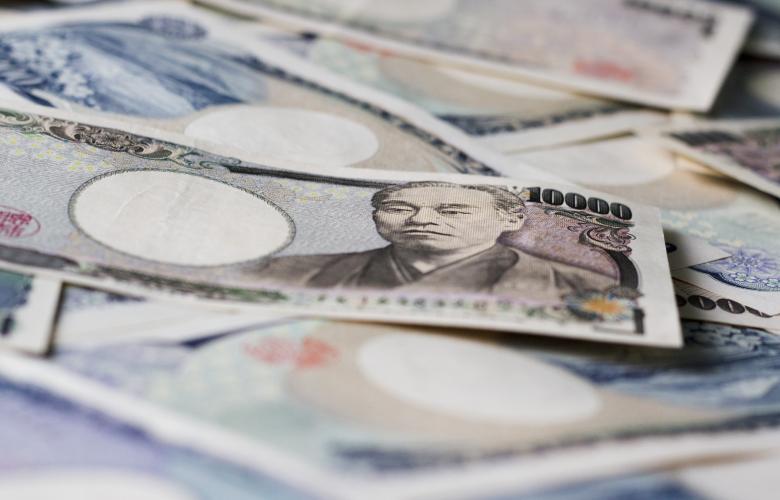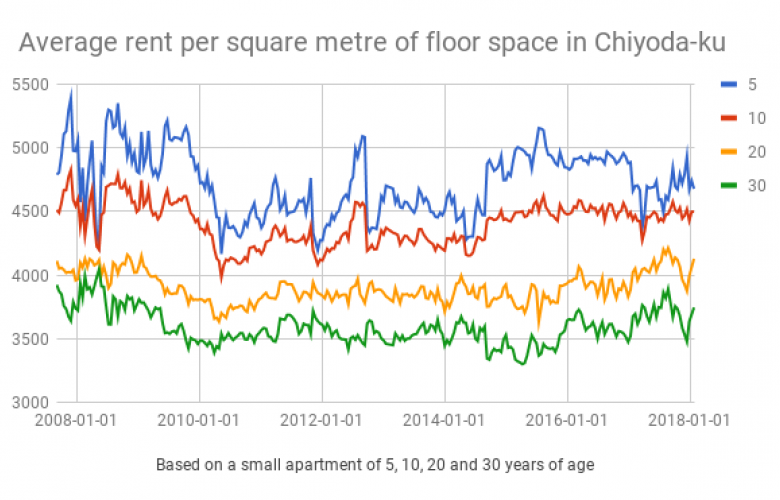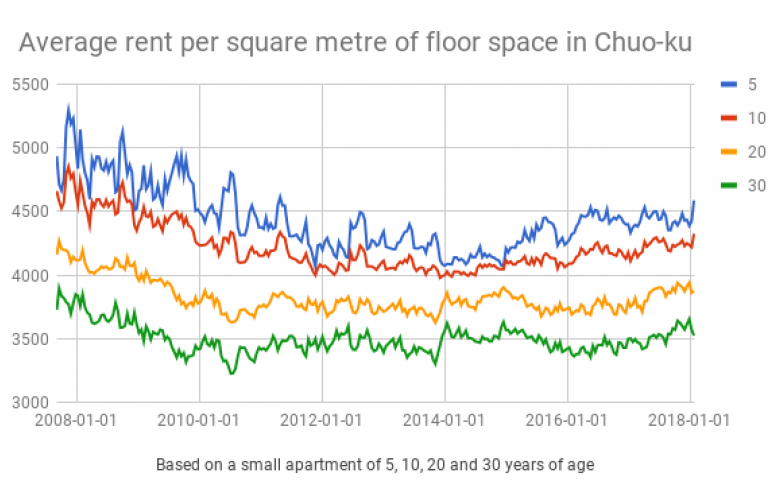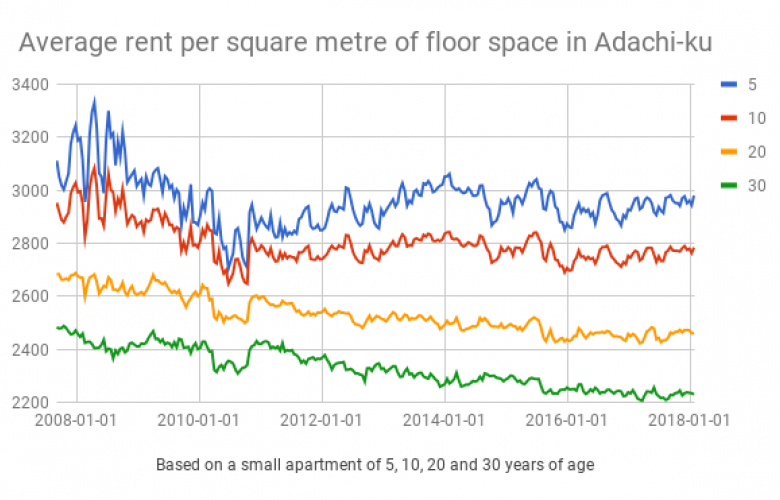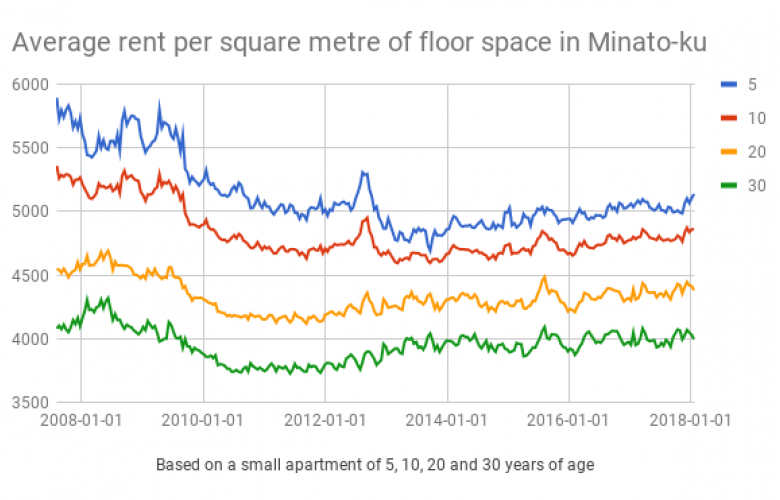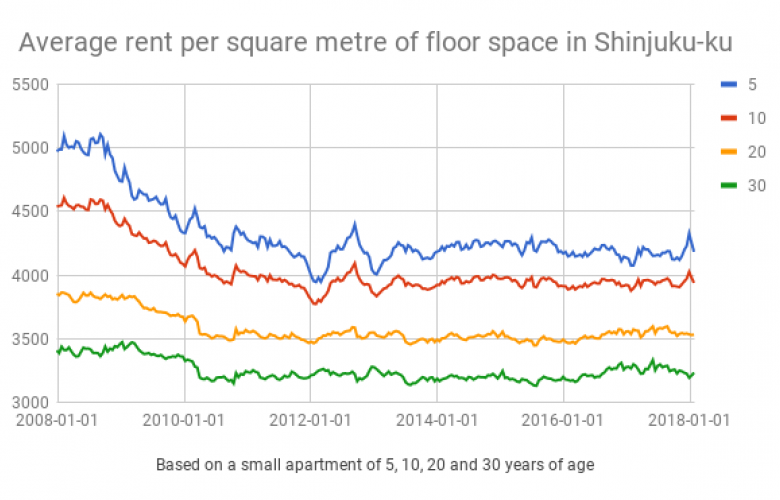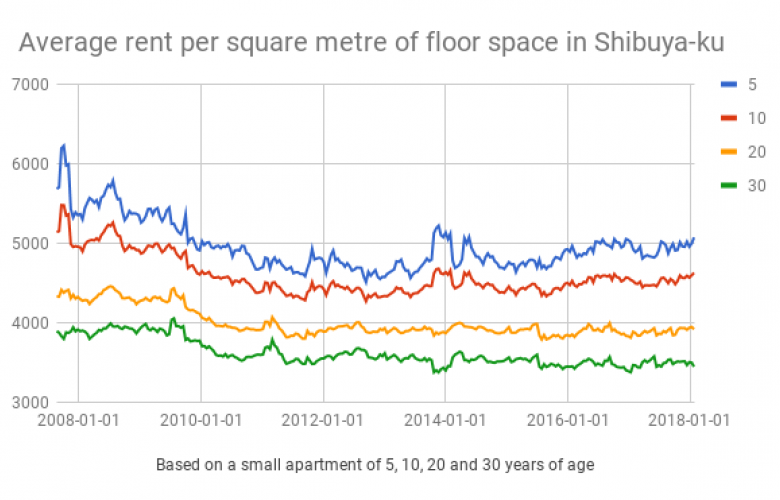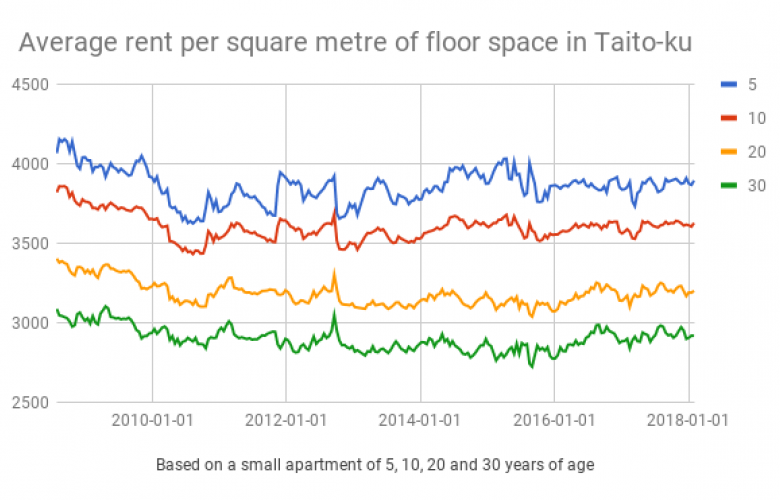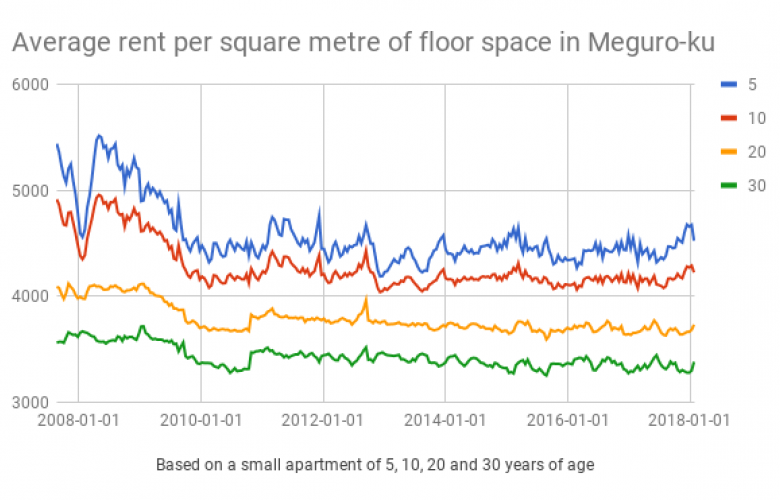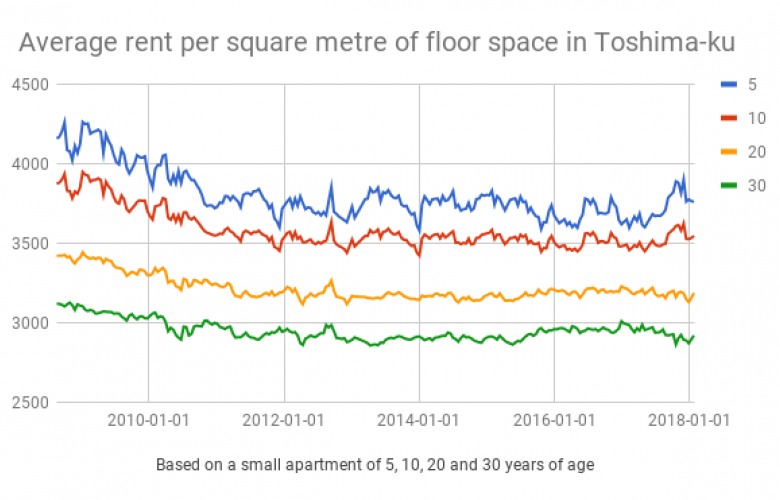Tokyo may seem like a prohibitively expensive place to reside, but a quick look at average rental prices for apartments busts that myth.
Compared to other major cities like London, New York, Sydney and Cape Town, where it's common to shell out 40 or even 50 percent of your monthly salary for rent, Tokyo comes in cheaper. Here, you can find decent accommodation for at most a third of your earnings, and companies often contribute for full-time employees.
That said, rent is on the rise in certain parts of the prefecture, so if you're looking to move to or within Tokyo, it pays to know what's potting, and where. Here's an overview of some of the neighbourhoods that seem to be getting pricier.
Note: The findings presented here are based on the average rent (when signing a lease), in Japanese yen, of a simple one-bedroom apartment (25m2) in the main wards of Tokyo over the past 12 months. Data source: Akasaka Real Estate.
Movers and shakers

Shinjuku
This ever-popular part of Tokyo has seen a small increase in average rents in recent months.
At the end of January 2017, a tenant could expect to hand over roughly 101,875 yen a month for a brand-new apartment (no older than five years), while a 10-year-old joint cost around 96,925 yen. A place that had been standing for 20 years went for close to 88,400 yen, while one that been around for 30 years was priced nearer 81,650 yen.
At the end of January this year, prices had shifted to 104,575 yen for the freshest abode and 98,475 yen for something in the 10-year region. 20-year-old options had decreased by 100 yen, while those in their third decade had dropped slightly to 80,825 yen - despite an overall increase in the past 24 months.
Readers hoping for a significant dip in Shinjuku rental prices would do well not to hold their breath.

Chuo
Over in Chuo Ward, also known as Tokyo central, rents are also on the rise (with a few dips here and there over the past year). However, it's worth noting that the area is more business than residential, so the number of home-dwellers is rather low.
At the end of January last year, one could expect to cough up about 109,375 yen per month for a flat no more than five years old, with rent dropping to around 103,800 yen for a pad 10 years of age, and perhaps 94,275 yen for a 20-year-old abode. The cost of an older apartment (30 years) was roughly 86,875 yen.
At the end of January 2018, average prices had increased to approximately 114,700 yen per month for a new flat, 108,100 yen for a decade-old option, and 96,850 yen for the 20-year age-group of accommodation. Golden oldies, meanwhile, had risen slightly to 88,125 yen.

Chiyoda
This area is an interesting one, as rents for both categories of newer apartments seem to have bounced back somewhat after a big dip and rocky few months. Rental rates for older dwellings, on the other hand, have risen steadily, only to dip and come up again in the past couple of months.
At the end of January last year, a tenant could expect to fork out around 116,550 yen a month for a sparkly new flat, or 110,825 yen for a place 10 years old. Apartments that had seen two decades went for around 100,550 yen, while those that had witnessed three cost closer to 91,875 yen.
At the end of January 2018, prices stood at 116,950 yen, 112,450 yen, 103,200 yen and 93,625 yen in each respective age category.
Known as the political centre of Tokyo, and, indeed, housing the national legislature, the official residence of the prime minister and the Imperial Palace, Chiyoda is not an especially residential area. Even with the odd trough in rental prices, one needs to be prepared to pay to stay.

Shibuya
Despite slight fluctuations over the past year, rents in one of the busiest parts of Tokyo are on the up.
At the end of January 2018, a new flat (five years) went for about 123,125 yen a month, a slightly older one (10 years) for 113,100 yen, a 20-year-old joint for 97,150 yen, and a grandpa pad (30 years) for 86,725 yen.
Fast-forward 12 months and the same places were going for around 126,825 yen, 115,700 yen, 97,950 yen and 86,200 yen respectively — the only drop in rent being for the golden-oldie category of apartment. Still, that may be good news for people looking to move into Shibuya, if they're prepared to rent an older place.

Minato
In the business and diplomatic hub of Minato, meanwhile, rents are generally on the rise after a bit of a dip.
The end of January last year saw new apartments (five years) being rented out for an average of 125,850 yen a month, while 10-year-old abodes were priced around 120,025 yen. Those in the 20- and 30-year age range went for 109,725 yen and 101,225 yen respectively.
Renters hoping for a bit of respite might not be thrilled to hear that these figures jumped to 128,425 yen and 121,525 yen in the three newer categories at the end of January this year. While the 20-year-old pads were 109,500 yen and 30-year-old places had dropped to 99,925 yen a month, this seems to be a blip in an otherwise upwards trend.

Meguro
Trendy Meguro has seen a fairly sharp rise (and wobble) in the price of newer apartments recently.
In late January 2017, a five-year-old flat rented in the region of 113,650 yen a month and a 10-year-old flat 105,075 yen, while 20-year-old pads went for closer to 91,350 and 30-year-old options 82,175 yen.
The same time this year, prices had shifted to 113,100 yen a month for brand-new apartments, marking a slight dip after a steady increase that took rentals all the way to 116,925 yen in mid-December. The other categories of apartment stood at 105,625 yen, 93,300 yen and 84,550 yen respectively.
Less wow, but still worth keeping an eye on

Toshima
Incorporating the hub of Ikebukuro, Toshima is a bustling blend of residential and business life. Its centrality might be one of the factors in the increase in rent (of newer apartments, anyway) that has been seen over the past year.
At the end of January 2017, a flat no older than five years could be rented for around 91,250 yen a month, with the price dipping to about 87,300 yen for apartments 10 years of age, 80,375 yen for pads that have been around for 20 years, and 74,750 yen for those that have seen three decades.
After a few peaks and troughs, average prices at the end of January 2018 were closer to 94,025 yen, 88,675 yen, 79,700 yen and 73,000 yen in each respective age category. Those thinking of moving into the area, then, might want to consider slightly older apartments if working with a tight budget — as those prices seem to be getting more affordable.

Adachi
Known as one of the lower-priced areas of Tokyo, Adachi has seen a very slight increase in average rents, with a few peaks and troughs along the way.
At the end of January 2017, a resident could expect to pay about 73,675 yen per month for a new (five years old or fresher) apartment, with the rate dropping to roughly 69,025 yen for a somewhat older apartment (10 years), and closer to 61,450 yen for something that has been around for 20 years or so. Prices were lower for even older buildings.
At the end of January this year, prices stood at roughly 74,500 yen per month for a new flat, 69,600 yen for a 10-year-old option, and 61,525 yen for a 20-year-old pad (making the price pretty stable). Prices for golden oldies (30 years) had dropped from 56,125 to 55,725 yen.

Taito
Rentals in tiny Taito, home to the popular areas of Asakusa and Ueno, have risen slightly recently, particularly for older apartments.
If you were renting from the end of January 2017, you could have expected to cough up around 96,300 yen a month for the newest of flats, 89,725 yen for a pad 10 years old, 79,275 yen for something close to 20, and a significantly lower 72,475 yen for a place three decades into its life.
At the end of January this year, a tenant could budget 97,350 yen a month for something five years or newer, 90,675 yen for a 10-year-old abode, and 80,025 yen and 72,950 yen for the older options respectively.
No huge price jump, but rental properties 20 and 30 years old do seem to be increasing in popularity in the area.
A word on older buildings in Tokyo
While many Japanese people eschew older buildings (for a number of reasons, including supposed comfort), they are generally fine to inhabit — and rents tend to be much cheaper for places that have passed the 20- or 30-year mark.
Earthquake safety is often cited as a concern when considering older abodes, but as long as the building went up after 1981, it's generally considered okay.
That was the year that Japan revised its building standards to provide greater protection against big shakes, and even buildings that are 35 years old are on the safe side of the law. However, you might want to exercise caution when it comes to buildings that date back to the 70s, 60s and beyond.
Disclaimer: The prices listed here are intended to provide rough estimates only, and should in no way be relied on for property decisions of any kind.
By Carey Finn
Similar to this:
Japan sees increased demand for city-centre condos
Is Japan forecasting the future of housing?
The 9 best places to Airbnb in Tokyo

